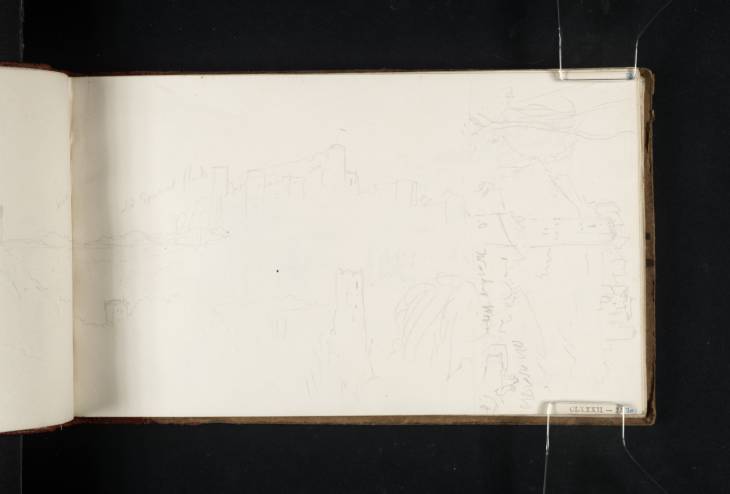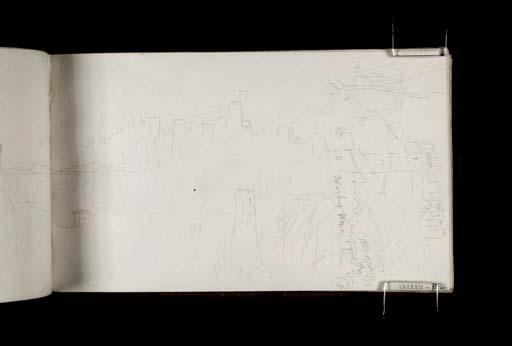Joseph Mallord William Turner View at Frascati; also Three Sketches of Marino, Including the Public Washhouse 1819
Image 1 of 2
Joseph Mallord William Turner,
View at Frascati; also Three Sketches of Marino, Including the Public Washhouse
1819
Joseph Mallord William Turner 1775–1851
Folio 28 Recto:
View at Frascati; also Three Sketches of Marino, Including the Public Washhouse 1819
D15347
Turner Bequest CLXXXII 28
Turner Bequest CLXXXII 28
Pencil on white wove paper, 113 x 189 mm
Inscribed by the artist in pencil ‘Ld Egremont Claude’ above horizon on left and ‘Washer women Marino’ bottom right of sketch in portrait format
Inscribed by John Ruskin in blue ink ‘28’ top right and ‘301’ bottom right
Stamped in black ‘CLXXXII 28’ bottom right
Inscribed by John Ruskin in blue ink ‘28’ top right and ‘301’ bottom right
Stamped in black ‘CLXXXII 28’ bottom right
Accepted by the nation as part of the Turner Bequest 1856
References
1909
A.J. Finberg, A Complete Inventory of the Drawings of the Turner Bequest, London 1909, vol.I, p.537, as ‘ “Frascati” with the “Villa Borgashe” “Ld Egremont’s Claude (?)”; also sketch at “Marino” ’.
1981
William Chubb, ‘Turner’s “Cicero at his Villa”’, Burlington Magazine, vol.123, July 1981, p.418.
1984
Cecilia Powell, ‘Turner on Classic Ground: His Visits to Central and Southern Italy and Related Paintings and Drawings’, unpublished Ph.D thesis, Courtauld Institute of Art, University of London 1984, pp.194 note 102, 195 note 107.
1987
Cecilia Powell, Turner in the South: Rome, Naples, Florence, New Haven and London 1987, p.[88] notes 78 and 79.
1990
Kathleen Nicholson, Turner’s Classical Landscapes: Myth and Meaning, Princeton 1990, p.262.
2002
Christopher Rowell, Ian Warrell and David Blayney Brown, Turner at Petworth, exhibition catalogue, Petworth House, Petworth 2002, p.187 [incorrectly as CLXXVII 27a].
2002
Ian Warrell, Blandine Chavanne and Michael Kitson, Turner et le Lorrain, exhibition catalogue, Musée des beaux-arts, Nancy 2002, pp.182, 191 under no.40 [incorrectly as CLXXXII 27v].
On the left-hand side of the page is the continuation of the view on the opposite sheet of the double-page spread which Turner has labelled ‘Frascati Villa Borgashe’, see folio 27 verso (D15346). His inscription, ‘Ld Egremont Claude’ refers to the oil painting, Landscape with Jacob and Laban and his Daughters circa 1654 (National Trust) belonging to the Earl of Egremont which Turner would have seen during his visits to Petworth House in West Sussex.1 Michael Kitson has suggested that the scenery of Frascati must have reminded him of parts of the picture.2 Within the sketch it is the topography directly below where Turner has made the inscription that the closest resemblance to Claude’s painting lies, particularly the land sloping away in the foreground and the mountains prominent in the distance. Turner may also have been recalling the colours of Claude’s masterpiece. A similar annotation can be found within the Route to Rome sketchbook (Tate D13908; Turner Bequest CLXXI 26a).
The remaining three sketches on the page all show buildings in Marino, a hillside town in the Alban Hills near Lake Albano. In particular, the subjects at the centre bottom, and on the right-hand side of the page drawn with the book held in portrait format, show the old public washhouse with its adjacent tower which still survives today, situated to the south of the town on the present-day Via Lavatoio. A less detailed view of the tower and rectangular trough can also be found on folio 27 verso (D15346). The subject may have been suggested by Turner’s recollection of a drawing by James Hakewill, ‘At the entrance to Marino from Albano’ 1817 (British School at Rome Library).3 This was clearly an established vista for travellers in the Alban Hills. The composition of the view recalls Turner’s small pen and ink copy of the view by John ‘Warwick’ Smith in the Italian Guide Book sketchbook (see Tate D13969; Turner Bequest CLXXII 20).4 It is also the same picturesque scene described by Charlotte Eaton in her travel guide, Rome in the Nineteenth Century, published 1820:
At Marino; a pretty little town, most picturesquely situated on the summit of a rocky hill , overhanging a romantic woody dell; we stopped to see the churches ... Pursuing our way, we walked down the steep hill into the romantic dell below, the carriages following. At the bottom, the bridge crossing the brawling stream; the rocks overhanging it, shaded by drooping plants; the ruined ivy-covered Gothic tower, rising far above the thick woods of oak and ilex; and the bright verdure of the gay meadows; formed one of the most delightful scenes I ever beheld, – admirably calculated for painting. In the foreground was the road abruptly winding round, and at one corner, a fountain and a large reservoir, at which the country women, in the most picturesque dresses imaginable, were washing and beating their clothes, talking and laughing with a hilarity that was quite new to us, after being so many months shut up with the sombre Romans.5
Nicola Moorby
May 2008
Reproduced in Christopher Rowell, Ian Warrell and David Blayney Brown, Turner at Petworth, London 2002, fig.66, p.70.
Michael Kitson, ‘Turner and Claude’, Turner Studies, Winter 1983, vol.2, no.2, p.12 and Ian Warrell, Blandine Chavanne and Michael Kitson, Turner et le Lorrain, exhibition catalogue, Musée des beaux-arts, Nancy 2002, p.182.
Tony Cubberley and Luke Herrmann, Twilight of the Grand Tour: A Catalogue of the drawings by James Hakewill in the British School at Rome Library, Rome 1992, no.5.23, p.248 reproduced.
See also James Barry (1741–1806), View of Marino with the Castel Gandolfo circa 1769, pencil, pen and ink, gray and brown wash (Fitzwilliam Museum, Cambridge), reproduced in William L. Pressly, ‘On Classic Ground: James Barry’s “Memorials” of the Italian Landscape’, Record of the Art Museum, Princeton University, Princeton 1995, vol.54, no.2, p.16, fig.3; Giovanni Battista Busiri (1698–1757), Fountain near Marino, gouache on paper (whereabouts unknown), reproduced in Denys Sutton (ed), An Italian Sketchbook by Richard Wilson RA, London 1968, p.41; and Ettore Roesler Franz (1845–1907), Donne al lavatoio di Marino 1875, watercolour (private collection), reproduced in Marco Testi, Ettore Roesler Franz: Un vedutista di fine ottocento a Tivoli nel Lazio, exhibition catalogue, Villa d’Este, Tivoli 2004, no.42, p.94.
How to cite
Nicola Moorby, ‘View at Frascati; also Three Sketches of Marino, Including the Public Washhouse 1819 by Joseph Mallord William Turner’, catalogue entry, May 2008, in David Blayney Brown (ed.), J.M.W. Turner: Sketchbooks, Drawings and Watercolours, Tate Research Publication, December 2012, https://www


